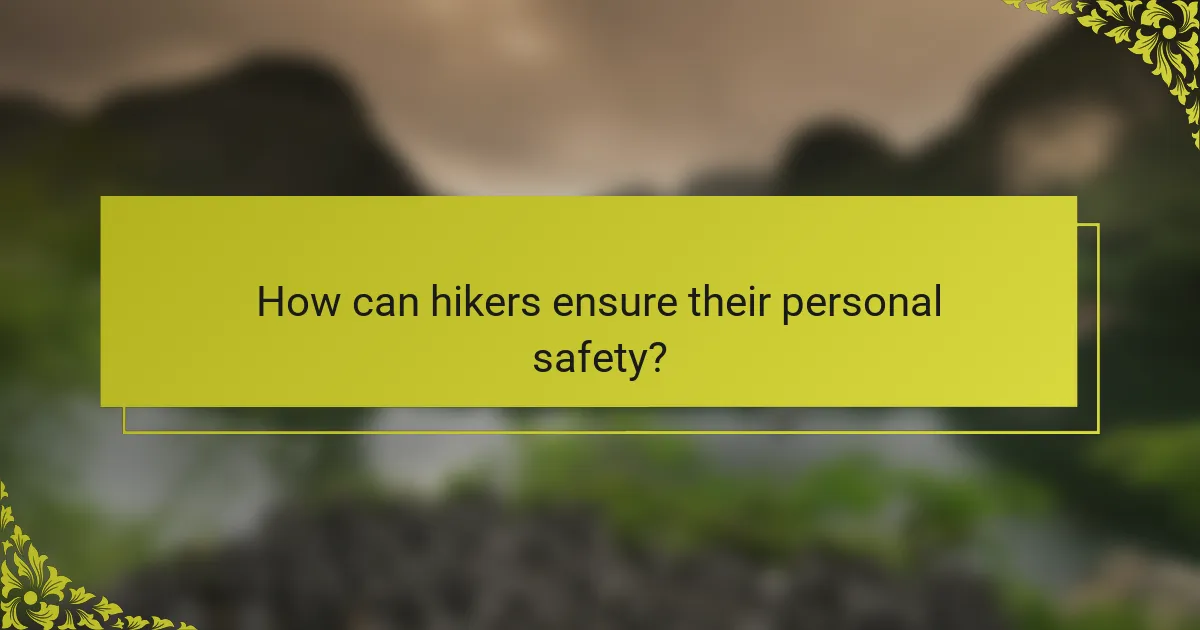Responsible hiking ensures safety, environmental protection, and respect for nature. Key practices include staying on marked trails, packing out trash, and being prepared with essential gear. Proper footwear and clothing enhance comfort and safety, while navigation tools and hydration systems are crucial for preparedness. Understanding regional challenges and avoiding common mistakes further contribute to a safe and enjoyable hiking experience.

What are the essential principles of responsible hiking?
Responsible hiking involves adhering to principles that ensure safety, environmental protection, and respect for nature. Key practices include staying on marked trails, packing out all trash, and respecting wildlife. Proper gear, such as durable footwear and weather-appropriate clothing, enhances safety and comfort. Always inform someone of your plans and check weather conditions before heading out.
Why is Leave No Trace important for hikers?
Leave No Trace is crucial for hikers because it promotes environmental stewardship and protects natural habitats. By following these principles, hikers minimize their impact on ecosystems, ensuring trails remain pristine for future generations. Responsible hiking practices foster a sustainable relationship with nature, enhancing the overall outdoor experience. Adopting Leave No Trace principles can reduce erosion, prevent wildlife disturbance, and maintain the beauty of hiking areas. This approach reflects a commitment to preserving the environment while enjoying outdoor activities.
How can hikers minimize their environmental impact?
Hikers can minimize their environmental impact by following Leave No Trace principles. These practices include staying on designated trails, packing out all trash, and respecting wildlife. Using eco-friendly gear, such as biodegradable soaps and reusable containers, reduces waste. Planning trips during off-peak times helps prevent overcrowding and habitat degradation.
What role does wildlife conservation play in hiking?
Wildlife conservation plays a crucial role in hiking by preserving natural habitats and ensuring biodiversity. Responsible hikers contribute to conservation efforts by minimizing their impact, which helps protect ecosystems and wildlife. This preservation enhances the hiking experience, allowing future generations to enjoy nature’s beauty. Additionally, understanding local wildlife can inform safer hiking practices, reducing human-wildlife conflicts.
Which ethical considerations should hikers keep in mind?
Hikers should prioritize Leave No Trace principles, respect wildlife, and stay on designated trails. These ethical considerations help preserve natural environments and ensure safety. Additionally, hikers should minimize noise, avoid disturbing other visitors, and pack out all trash. Practicing these guidelines fosters a responsible hiking culture and protects ecosystems.

What gear is necessary for a safe hiking experience?
Essential gear for a safe hiking experience includes sturdy footwear, appropriate clothing, navigation tools, hydration systems, and first aid kits. These items ensure comfort, safety, and preparedness on the trail.
1. Sturdy Footwear: Supportive hiking boots with good traction prevent slips and blisters.
2. Appropriate Clothing: Moisture-wicking layers and weather-resistant outerwear adapt to changing conditions.
3. Navigation Tools: Maps, compasses, or GPS devices help avoid getting lost.
4. Hydration Systems: Water bottles or hydration packs ensure adequate fluid intake.
5. First Aid Kits: Basic medical supplies address minor injuries and emergencies.
Which types of footwear are best suited for different terrains?
Trail running shoes are best for rocky terrains, while waterproof hiking boots excel in wet conditions. For sandy surfaces, lightweight footwear offers better maneuverability. Snow and ice require insulated boots with good traction. Muddy paths benefit from shoes with deep treads. Urban hiking is suited for comfortable sneakers.
How do weather conditions influence gear selection?
Weather conditions significantly influence gear selection for hiking. Adapting gear to factors like temperature, precipitation, and wind ensures safety and comfort.
In cold weather, insulated layers, waterproof jackets, and thermal accessories are essential. For hot conditions, lightweight, breathable fabrics and hydration systems are crucial. Rainy weather demands waterproof gear and quick-drying materials. Windy conditions require windbreakers and sturdy footwear to prevent injuries.
Selecting appropriate gear enhances the hiking experience, reduces risks, and improves overall enjoyment. Always check weather forecasts before heading out to make informed gear choices.
What are the must-have items for a day hike?
Essential items for a day hike include water, snacks, a map, a first aid kit, appropriate clothing, and a flashlight. These items ensure safety and comfort. Always carry enough water, at least 2 liters, to stay hydrated. Snacks should provide energy, such as trail mix or energy bars. A map or GPS device helps navigate trails. A first aid kit is vital for treating minor injuries. Dress in layers to adapt to changing weather conditions. A flashlight is necessary for unexpected delays or low-light situations.
Which tools enhance navigation and safety on the trail?
Tools that enhance navigation and safety on the trail include GPS devices, compasses, maps, and safety gear like first aid kits. These tools provide essential information and support for responsible hiking.
GPS devices offer real-time location tracking, ensuring hikers stay on course. Compasses are reliable in low-visibility conditions, while detailed maps help in planning routes. First aid kits provide necessary supplies for emergencies, enhancing overall safety.
In addition, trail apps on smartphones can offer additional features like weather updates and trail conditions. Using a combination of these tools ensures a safer and more enjoyable hiking experience.

How can hikers ensure their personal safety?
Hikers can ensure their personal safety by preparing adequately, staying aware of their surroundings, and using proper gear. Always plan your route and inform someone about your itinerary. Carry essential items like a first aid kit, map, and compass. Wear appropriate clothing and footwear for the terrain. Stay hydrated and take breaks to avoid exhaustion. Be mindful of weather conditions and adjust your plans accordingly. Familiarize yourself with wildlife safety protocols to prevent encounters.
What are the best practices for trail preparedness?
To prepare for a trail effectively, follow these best practices: research your route, check weather conditions, pack essential gear, and inform someone of your plans.
Start by understanding trail difficulty and length to match your skill level. Carry a map, compass, and GPS device for navigation. Pack adequate water, snacks, and a first aid kit for emergencies. Dress in layers suitable for changing weather, and wear appropriate footwear for stability.
Before heading out, verify the trail’s accessibility and any potential hazards. This preparation helps ensure a safe and enjoyable hiking experience.
How should hikers assess their fitness level before a hike?
Hikers should assess their fitness level by evaluating endurance, strength, and experience. Start with a self-assessment of your cardiovascular fitness through activities like jogging or cycling. Consider your hiking experience, including terrain and distance, to gauge comfort levels. Additionally, test your strength with exercises such as squats or lunges, focusing on leg and core strength. Finally, consult a fitness professional if unsure about your readiness for specific trails.
What strategies can hikers use to avoid getting lost?
Hikers can avoid getting lost by using navigation tools, planning routes, and staying aware of their surroundings. Carry a map and compass, or use a GPS device to track your location. Before starting, study the trail and familiarize yourself with key landmarks. Regularly check your position and make adjustments as needed. Stay on marked paths to minimize confusion and avoid straying off course. Additionally, inform someone of your hiking plans, including expected return times, to enhance safety.

How does hiking culture vary across different regions?
Hiking culture varies significantly across regions, influenced by geography, climate, and local traditions. In mountainous areas, hikers prioritize safety gear and navigation tools due to challenging terrains. Coastal regions emphasize lightweight gear for beach hikes and water access. Urban hiking culture often incorporates social aspects, with group hikes and community events being popular. In contrast, rural areas focus on solitude and immersion in nature, highlighting the need for minimal impact practices. Each region’s unique environmental factors shape the best practices and safety tips for responsible hiking.
What are popular hiking destinations in various countries?
Popular hiking destinations include the Inca Trail in Peru, the Appalachian Trail in the USA, Torres del Paine in Chile, and the Dolomites in Italy. Each offers unique landscapes and experiences for hikers.
Inca Trail | Peru | Ancient ruins, stunning mountain views, 4-day trek
Appalachian Trail | USA | 2,190 miles, diverse ecosystems, long-distance hiking
Torres del Paine | Chile | Breathtaking granite peaks, wildlife, multi-day circuits
Dolomites | Italy | Dramatic rock formations, via ferrata routes, scenic beauty
Mount Fuji | Japan | Iconic volcano, cultural significance, accessible climbing route
Zion National Park | USA | Unique canyoneering, varied trails, stunning vistas
How do local regulations affect hiking practices?
Local regulations significantly shape hiking practices by establishing guidelines for safety, conservation, and access. These rules may include trail usage restrictions, permits, and designated areas for hiking. Compliance with these regulations ensures the preservation of natural environments and enhances the safety of hikers. For example, some parks may limit the number of visitors to reduce environmental impact. Additionally, regulations often dictate the types of gear allowed, such as specific footwear or equipment for safety. Understanding and adhering to local regulations is essential for responsible hiking and enjoying nature safely.
Which cultural norms should hikers respect in different areas?
Hikers should respect local cultural norms, which vary by region. Understanding and honoring these practices enhances the hiking experience and fosters positive interactions with local communities.
1. Research local customs before hiking in a new area.
2. Follow guidelines regarding sacred sites and local traditions.
3. Observe dress codes specific to certain regions or cultures.
4. Minimize noise to respect the natural environment and local wildlife.
5. Ask for permission before photographing people or private property.
6. Support local businesses and artisans to contribute to the community.

What unique challenges do hikers face in specific environments?
Hikers face unique challenges in specific environments, including extreme weather, terrain variations, and wildlife encounters. For example, alpine hikes may involve altitude sickness, while desert hikes present dehydration risks.
Additionally, dense forests can obscure trails, making navigation difficult. Coastal hikes may involve tides and unstable ground. Understanding these challenges helps hikers prepare effectively.
How does altitude affect hiking experience and safety?
Altitude significantly impacts hiking experience and safety by affecting oxygen levels and weather conditions. Higher altitudes can lead to altitude sickness, which may cause headaches, nausea, and fatigue. Acclimatization is essential; spending time at intermediate elevations helps the body adjust. Weather can change rapidly in mountainous areas, increasing risks of hypothermia and storms. Hikers should monitor conditions and carry appropriate gear, such as layered clothing and hydration systems. Understanding altitude effects enhances safety and enjoyment during hikes.
What are the risks of hiking in extreme weather conditions?
Hiking in extreme weather conditions poses significant risks, including hypothermia, heat exhaustion, and injury from falls. Proper preparation and equipment can mitigate these dangers.
Hypothermia occurs when body temperature drops due to cold, wet, or windy conditions. It can be life-threatening and often results from inadequate clothing. Heat exhaustion, on the other hand, can happen in high temperatures and leads to dehydration and fatigue.
In addition to temperature-related risks, extreme weather can cause hazardous trail conditions. Rain and snow can create slippery surfaces, increasing the likelihood of falls. Lightning poses another serious threat, especially in exposed areas.
To ensure safety, hikers should check weather forecasts, carry appropriate gear, and inform others of their plans. This proactive approach can significantly reduce the risks associated with hiking in extreme weather.
How can hikers prepare for wildlife encounters?
Hikers can prepare for wildlife encounters by understanding animal behavior, carrying bear spray, and making noise to alert animals. Awareness of surroundings is crucial, as is knowing how to react in different scenarios. Informing others of your hiking route enhances safety.

What are the common mistakes to avoid while hiking?
Common mistakes to avoid while hiking include inadequate preparation, neglecting weather conditions, and not respecting trail etiquette. These errors can lead to safety risks and diminish the hiking experience.
1. Failing to plan the route properly: Know the trail length, difficulty, and any potential hazards.
2. Ignoring weather forecasts: Always check the weather before heading out and be prepared for changes.
3. Overpacking or underpacking: Carry essential gear but avoid unnecessary weight; balance is key.
4. Not staying on marked trails: Straying off trails can damage ecosystems and increase the risk of getting lost.
5. Forgetting to hydrate: Dehydration can occur quickly; drink water regularly throughout the hike.
6. Neglecting to inform someone of your plans: Always let a friend or family member know your hiking route and expected return time.
How can hikers prevent injuries on the trail?
Hikers can prevent injuries on the trail by following essential safety tips. Wear appropriate footwear to ensure stability and traction. Maintain a steady pace and stay hydrated to avoid fatigue. Use trekking poles for balance on uneven terrain. Plan your route and be aware of weather conditions. Stretch before and after hiking to enhance flexibility and reduce strain.
What should hikers know about hydration and nutrition?
Hikers should prioritize hydration and balanced nutrition to maintain energy and prevent dehydration. Carry at least half a liter of water for every hour of hiking. Include high-energy snacks like nuts and energy bars to sustain energy levels. Consider electrolyte supplements for longer hikes to replenish lost minerals.
Which gear mistakes can lead to unsafe hiking experiences?
Using improper gear can lead to unsafe hiking experiences. Common mistakes include using worn-out footwear, neglecting weather-appropriate clothing, and failing to pack essential navigation tools.
Worn-out footwear can cause blisters and injuries, while inadequate clothing may lead to hypothermia or heat exhaustion. Not carrying a map or compass can result in getting lost, especially in unfamiliar terrain. Additionally, overloading a backpack can lead to fatigue and decreased mobility.
Proper gear selection and maintenance are vital for safety. Regularly inspect equipment and replace items that show signs of wear. Always consider the specific conditions of the hike, such as terrain and weather, to ensure adequate preparation.

How can hikers stay informed about trail conditions?
Hikers can stay informed about trail conditions by checking reliable sources such as park websites, trail apps, and local hiking groups. These platforms provide real-time updates on weather, closures, and hazards. Engaging with fellow hikers through social media can also yield valuable insights.
What resources are available for checking trail updates?
Several resources are available for checking trail updates. Online platforms like AllTrails and Trailforks provide real-time information on trail conditions. Local park websites often feature alerts on closures or hazards. Social media groups focused on hiking communities can also share timely updates. Additionally, mobile apps like Hiking Project offer user-generated reports on trail status.
How can hiking communities support each other?
Hiking communities can support each other by sharing resources, knowledge, and experiences. They can organize group hikes, workshops, or training sessions to enhance skills and safety awareness.
Encouraging responsible hiking practices is vital. Communities can establish guidelines on Leave No Trace principles, promoting environmental stewardship. Regular communication through social media or local forums fosters a sense of belonging and accountability.
Mentorship programs can pair experienced hikers with novices, providing guidance on gear selection and trail navigation. This unique attribute enhances safety and builds confidence among new hikers.
Lastly, communities can collaborate on local conservation efforts, ensuring trails remain accessible and well-maintained. This rare attribute strengthens community bonds and promotes sustainability in hiking activities.
What technology can enhance hiking experiences?
Technology can significantly enhance hiking experiences through navigation tools, safety devices, and gear innovations. GPS devices and smartphone apps provide real-time maps and trail information, reducing the risk of getting lost. Wearable technology, such as fitness trackers and smartwatches, monitor health metrics, ensuring hikers maintain optimal performance. Portable solar chargers enable extended trips by keeping devices powered. Additionally, advanced outdoor gear, like lightweight tents and breathable fabrics, improves comfort and convenience. These technologies promote responsible hiking by enhancing safety and enjoyment.
What expert tips can enhance responsible hiking practices?
To enhance responsible hiking practices, prioritize preparation, safety, and environmental respect. Always plan your route and check weather conditions. Use proper gear, including sturdy footwear and navigation tools. Stay on marked trails to protect wildlife and ecosystems. Carry out all trash and minimize campfire impact. Educate yourself about local flora and fauna to avoid harmful interactions.




